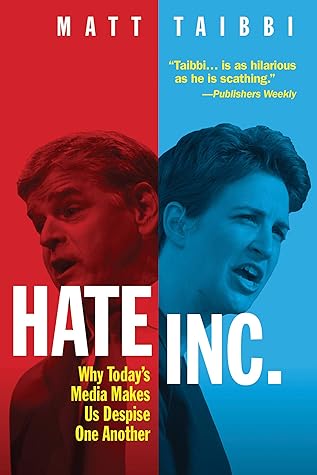More on this book
Community
Kindle Notes & Highlights
by
Matt Taibbi
Read between
April 3 - April 10, 2022
Both networks identified core audiences and fed them constant doses of affirming content.
sports-like format of stoking fan bases.
Whether the motivation was political or financial, the reality by late 2016 and early 2017 was that most commercial news organizations spoke exclusively to one “side” or another.
Democrats by 2020 were 91 percent of the New York Times audience and 95 percent of MSNBC’s, while Republicans were 93 percent of Fox viewers.
This reduced the incentive to be careful.
News was now more about underlying narratives audiences felt were true and important.
Fox and MSNBC already knew how to monetize anger by setting audiences against one another.
permission to play loose with facts by gobbling up anonymously-sourced exposes that tickled their outrage centers.
The extreme danger from the beginning of the Trump era was not just that the White House might be occupied by an unfit person, but that American institutions might follow him into further disrepute.
the press was now working in collaboration with Trump,
simplistic mirror image,
The only losers were the American people, who were now more steeped in hate than ever.
The subject here is the phasing out of independent journalism, replacing it with deeply politicized programming on both “sides.” Which “side” is better is immaterial: neither approach is journalism.
this book is intended to help start a conversation about how much of our disdain for each other is real, and how much of it is a product of the media machine.
the idea of this book is really an attempt to help you sort out how much of your anger and fear is real, and how much of the upset in your head comes from people like me, pushing your buttons for cash.
they sold intramural conflict.
get both viewers literally addicted to hating one another.
We sold anger, and we did it mainly by feeding audiences what they wanted to hear. Mostly, this involved cranking out stories about people our viewers loved to hate.
The modern news consumer tuned into news that confirmed his or her prejudices about whatever or whoever the villain of the day happened to be: foreigners, minorities, terrorists, the Clintons, Republicans, even corporations.
The news, basically, is bait to lure you into a pen where you can be sold
whatever else studies say people of your age, gender, race, class, and political persuasion tend to buy.
there is a utility in keeping us divided. As people, the more separate we are, the more politically impotent we become.
we’re trained to consume the news the way sports fans do. We root for our team, and hate all the rest.
We manufactured fake dissent, to prevent real dissent.
An example was Ralph Nader, who focused on the entire system of commercial media. Nader said that campaign coverage had devolved into a profit bonanza in which media firms “cash in and give candidates a free ride.”
The pretense that the presidential campaign was anything but an insane, absurdist reality show was almost completely gone by that point.
So long as we thought he couldn’t actually win, most of us in the press were hugely entertained, even flattered.
“The choice between what cuts into your bottom lines and what harms us as a society is an important one,” he scolded.
Ultimately Obama landed near to Kristof in this critique: “A job well done is about more than just handing someone a microphone. It is to probe and to question, and to dig deeper, and to demand more.”
such reports got lots of clicks from blue-state voters, thanks to the same dynamic that inspires sports fans to read rosy predictions even when their teams suck.
On the plane, two businesses were going on in tandem. The candidates were raising money, which mostly entailed taking cash from big companies in exchange for policy promises. In the back, reporters were gunning for hits and ratings.
It turns out we let our electoral process devolve into something so fake and dysfunctional that any half-bright con man with the stones to try it could walk right through the front door and tear it to shreds on the first go.
To me the 2016 campaign was just a particularly dramatic demonstration of the “siloing” phenomenon, in which media content—not just news, but all content, entertainment
included—is tailored for the consumption of highly individualized demographics.
Most outlets, whether they admitted it or not, basically chose to double down with half the news audience, rather than concede all of it.
pro-Trump and anti-Trump.
Both takes would sell extremely well, in respective venues. But this formalized our descent into a sportslike coverage paradigm, which had been building for decades.
People believed us less, but watched us more.
After generations of doing the opposite, when unity and conformity were more profitable, now the primary product the news media sells is division.
To make money, we’ve had to train audiences to consume news in a certain way. We need you anxious, pre-pissed, addicted to conflict.
So long as the public is busy hating each other and not aiming its ire at the more complex financial and political
processes going on off-camera, there’s very little danger of anything like a popular uprising.
The news today is a reality show where you’re part of the cast: America vs. America, on every channel.
The Ten Rules of Hate:
“The intellectual level of cable news is one step above pro wrestling.”
Though most of our problems are systemic, most of our public debates are referendums on personality.
public interest standard
Fairness Doctrine
Most problems are systemic, bipartisan, and bureaucratic, and most of us, by voting or not voting, paying taxes or not, own a little bit of most disasters.
They’re hard to sell. And the ability to market a story is everything.


